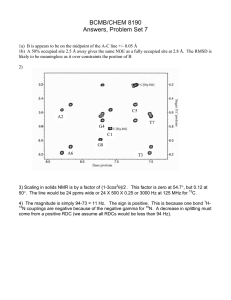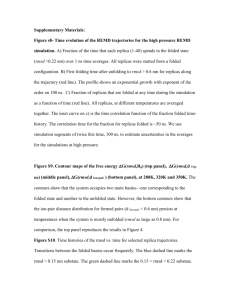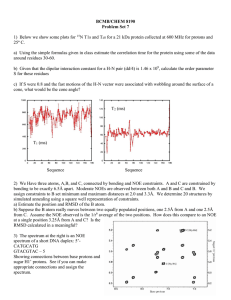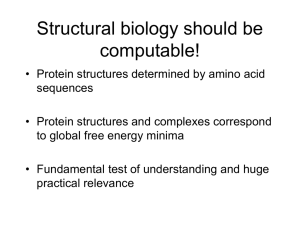A normalized root-mean-square distance for comparing protein
advertisement
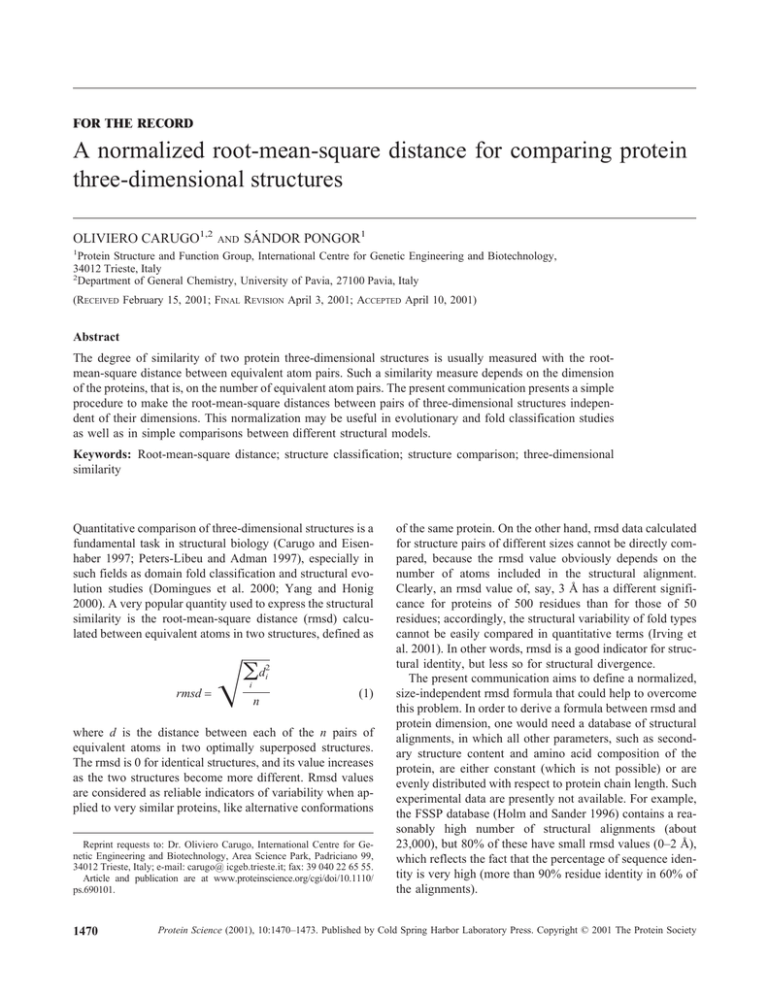
FOR THE RECORD A normalized root-mean-square distance for comparing protein three-dimensional structures OLIVIERO CARUGO1,2 AND SÁNDOR PONGOR1 1 Protein Structure and Function Group, International Centre for Genetic Engineering and Biotechnology, 34012 Trieste, Italy 2 Department of General Chemistry, University of Pavia, 27100 Pavia, Italy (RECEIVED February 15, 2001; FINAL REVISION April 3, 2001; ACCEPTED April 10, 2001) Abstract The degree of similarity of two protein three-dimensional structures is usually measured with the rootmean-square distance between equivalent atom pairs. Such a similarity measure depends on the dimension of the proteins, that is, on the number of equivalent atom pairs. The present communication presents a simple procedure to make the root-mean-square distances between pairs of three-dimensional structures independent of their dimensions. This normalization may be useful in evolutionary and fold classification studies as well as in simple comparisons between different structural models. Keywords: Root-mean-square distance; structure classification; structure comparison; three-dimensional similarity Quantitative comparison of three-dimensional structures is a fundamental task in structural biology (Carugo and Eisenhaber 1997; Peters-Libeu and Adman 1997), especially in such fields as domain fold classification and structural evolution studies (Domingues et al. 2000; Yang and Honig 2000). A very popular quantity used to express the structural similarity is the root-mean-square distance (rmsd) calculated between equivalent atoms in two structures, defined as rmsd = 冑 兺d i n 2 i (1) where d is the distance between each of the n pairs of equivalent atoms in two optimally superposed structures. The rmsd is 0 for identical structures, and its value increases as the two structures become more different. Rmsd values are considered as reliable indicators of variability when applied to very similar proteins, like alternative conformations Reprint requests to: Dr. Oliviero Carugo, International Centre for Genetic Engineering and Biotechnology, Area Science Park, Padriciano 99, 34012 Trieste, Italy; e-mail: carugo@ icgeb.trieste.it; fax: 39 040 22 65 55. Article and publication are at www.proteinscience.org/cgi/doi/10.1110/ ps.690101. 1470 of the same protein. On the other hand, rmsd data calculated for structure pairs of different sizes cannot be directly compared, because the rmsd value obviously depends on the number of atoms included in the structural alignment. Clearly, an rmsd value of, say, 3 Å has a different significance for proteins of 500 residues than for those of 50 residues; accordingly, the structural variability of fold types cannot be easily compared in quantitative terms (Irving et al. 2001). In other words, rmsd is a good indicator for structural identity, but less so for structural divergence. The present communication aims to define a normalized, size-independent rmsd formula that could help to overcome this problem. In order to derive a formula between rmsd and protein dimension, one would need a database of structural alignments, in which all other parameters, such as secondary structure content and amino acid composition of the protein, are either constant (which is not possible) or are evenly distributed with respect to protein chain length. Such experimental data are presently not available. For example, the FSSP database (Holm and Sander 1996) contains a reasonably high number of structural alignments (about 23,000), but 80% of these have small rmsd values (0–2 Å), which reflects the fact that the percentage of sequence identity is very high (more than 90% residue identity in 60% of the alignments). Protein Science (2001), 10:1470–1473. Published by Cold Spring Harbor Laboratory Press. Copyright © 2001 The Protein Society Normalized root-mean-square distance We therefore decided to create a large artificial set of rmsd values via extensive self-comparison of 180 nonhomologous (maximal identity 25%) protein structures, selected from the protein data bank (Berman et al. 2000) using the PDB_SELECT (Hobohm and Sander 1994) algorithm. These proteins were selected so as to represent the largest possible variability of amino acid content, sequence length as well as secondary structure content (Table 1). Each structure was compared, using the algorithm of Kabsch (1976, 1978), with 400,000 of its randomized variants created through random shuffling of the C␣ equivalencies. All C␣ atoms were included in superposing each structure with all its variants. Overall, we obtained 400,000 rmsd observations in each of the 180 randomization experiments, which corresponds to a database of 72 million structural alignments. As expected, the distribution of rmsd values thus obtained depends on the size of the protein. The rmsd values are not evenly distributed, rather, the histograms are biased toward the high rmsd values (Fig. 1a). Moreover, there are characteristic differences between proteins of different length, illustrated by, for example, the different rmsd limits of the 2000 smallest rmsd values in the two experiments, as shown by the shaded areas in Figure 1a. In order to check the effect of the uneven distribution of rmsd values, we prepared separate rmsd-versus-chainlength plots for different subsets of the database, selected to represent different rmsd ranges without changing the other parameters (secondary structure content, amino acid composition, etc.). This was achieved by first ordering the structural alignments in growing order of the rmsd values in each of the 180 data sets and then selecting the first n smallest rmsd values from each data set. This procedure guarantees that the data sets will be equal with respect to all parameters; only the range of the rmsd values will be different: that is, gradually increasing the number n of observations in the data sets means not only an increase of the data size but Fig. 1. (a) Typical distributions of rmsd values after 400,000 random superpositions for proteins of different sizes (PDB codes indicated in parentheses); the percentage of observations in each range of 0.4 Å is reported. (b) A typical rmsd-versus-chain-length plot; the upper limits of the smallest 2000 observations (examples indicated by perpendicular lines in a) are plotted for each of the 180 experiments. (c) The dependence of the rmsd-versus-chain-length plots as a function of the different number of smallest observations (indicated in parentheses); the lines were determined by fitting a logarithmic equation of the form y ⳱ a + b ln(x) to the data (0.95 < r < 1.00); 䊊 is a reference value, corresponding to 100 residues, chosen to normalize the curves. (d) Dividing the rmsd values by the corresponding reference value (indicated with 䊊 in c) causes the curves in the previous figure to collapse into one single curve. www.proteinscience.org 1471 Carugo and Pongor Table 1. Protein structures examined in the present work idcode n h e t o idcode n h e t o idcode n h e t o 1a7kA 1amx_ 1auxA 1b12A 1b87A 1bq2_ 1bor_ 1bu2A 1by1A 1c20A 1ckv_ 1dldA 1dgvA 1eus_ 1gcf_ 1hcd__ 1ihfA 1ksr_ 1mtyB 1pgs_ 1pyaA 1qleC 1qrjB 1qstA 1r63_ 1stu_ 1tig_ 1upuA 2af8_ 2ezl_ 2pcbA 2qwc_ 2yfpA 3sil_ 8rucI 1a7m_ 1aru_ 1b3kA 1beg_ 1bw6A 1cby_ 1cmyA 1d8lA 1dkdA 1ej3A 1gdoA 1irl_ 1mut_ 1otfA 1pdnC 1qhgA 1qkfA 1qu8A 1rypL 1tiiD 1vcaA 2aviA 2bidA 2shl_ 3stdA 358 150 292 239 181 323 56 229 209 128 141 220 183 358 109 118 96 100 384 311 81 273 199 160 63 68 88 224 86 99 294 385 224 378 123 180 336 373 97 56 227 141 140 146 187 238 133 129 59 123 163 73 46 212 98 199 121 197 48 162 31 8 29 8 27 32 0 60 64 65 16 58 46 3 0 3 42 0 64 5 27 68 57 35 67 38 35 39 50 59 49 3 9 6 22 58 43 31 61 55 30 74 39 34 61 25 52 12 42 47 56 22 0 39 26 5 2 57 0 30 25 54 31 46 30 28 4 0 0 3 21 0 2 44 44 49 29 43 1 47 27 1 1 29 0 31 35 27 0 0 7 45 53 47 24 0 7 31 4 0 30 0 29 29 4 34 3 23 32 5 10 21 0 33 39 57 51 0 52 48 25 21 20 20 28 21 55 27 25 15 36 25 31 28 20 30 9 36 19 22 22 16 22 22 16 12 16 15 21 19 22 25 24 25 27 22 24 21 14 23 16 15 19 17 18 21 22 28 10 24 20 27 50 16 21 20 22 21 27 14 19 17 20 26 15 19 41 14 11 17 27 17 20 25 36 19 20 21 16 26 23 16 20 14 17 19 14 18 29 22 21 26 14 22 28 19 26 17 21 21 24 11 14 19 17 20 23 37 15 24 15 30 50 12 14 19 24 22 21 9 1agnA 1aojA 1avgI 1b6bA 1b9lA 1bhu_ 1bp3A 1buyA 1bynA 1ceuA 1cn3A 1d2hA 1dtjB 1evtD 1gnhA 1hoe_ 1iyu_ 1lbd_ 1nfdA 1pho_ 1qhkA 1qmcA 1qslA 1qu0C 1rgs_ 1svpA 1tiv_ 1xikA 2cgpA 2jhbA 2pcfB 2tbd_ 3cla_ 7prcC 1a3k_ 1a8p_ 1avwB 1b65A 1bmy_ 1bx9A 1cczA 1cpzA 1dipA 1dztA 1eqfA 1ghj_ 1lkfA 1nflA 1ounB 1pex_ 1ghlA 1qovM 1r2aA 1sxl_ 1tuc_ 2abd_ 2ayh_ 2nlrA 2trxA 5daaA 373 60 142 168 119 102 186 166 128 51 283 252 62 192 206 74 79 238 203 330 47 52 402 183 264 160 86 340 200 143 250 134 213 332 137 257 171 363 107 210 171 68 77 183 267 79 292 259 121 192 203 302 46 97 61 86 214 222 108 277 30 5 8 26 32 4 60 57 5 51 7 32 44 9 9 0 0 66 5 2 32 6 34 3 34 6 0 70 40 26 8 28 30 42 2 26 2 31 48 56 4 28 40 10 64 0 3 58 28 7 37 64 63 18 5 60 6 6 33 27 26 45 41 30 39 25 0 1 48 0 41 31 32 52 44 49 47 3 43 56 28 56 29 51 27 46 0 4 30 25 40 27 29 4 58 34 42 26 0 10 51 29 0 44 0 42 59 0 49 42 27 4 0 13 44 0 52 50 28 31 21 22 27 21 17 35 22 20 18 25 25 19 6 13 21 26 25 20 22 25 21 21 19 22 17 26 50 13 19 24 23 21 22 30 18 23 20 18 27 23 22 28 31 21 21 25 20 29 12 33 19 14 11 30 21 19 19 23 27 23 23 28 25 23 12 36 18 22 29 24 27 18 18 26 26 26 28 12 30 16 19 17 18 24 21 23 50 14 12 24 28 24 20 24 21 18 36 24 25 11 24 15 29 25 15 33 18 13 11 18 16 18 26 39 30 21 23 21 12 19 1ak0_ 1ap8_ 1axn_ 1b6rA 1b9xA 1boeA 1bqv_ 1bxwA 1cl7M 1cflD 1d0mA 1de9A 1dujA 1ewiA 1gsa_ 1hsm_ 1jlyA 1liaA 1oczB 1pslA 1qklA 1qqvA 1qsoA 1qu5A 1rip_ 1tbaA 1tnm_ 1xrc_ 2def_ 2myo_ 2pii_ 2tmvP 3csmA 8prn_ 1a79A 1aep_ 1awj_ 1bec_ 1bu9A 1cd3_ 1cjkA 1d4uA 1dj7B 1eioA 1exg_ 1hhhB 1mrj_ 1nfa_ 1p32A 1qgiA 1qj8A 1qpvA 1rof_ 1tif_ 1u2fA 2atcB 2bby_ 2nmbA 3ncmA 6gsvA 264 213 323 349 340 46 110 172 142 368 312 276 187 114 314 79 299 164 227 304 127 67 149 182 81 67 91 378 146 118 112 154 252 289 171 153 77 238 168 294 189 111 73 127 110 100 247 178 182 259 148 133 60 76 90 152 69 147 92 217 64 21 79 34 7 0 46 0 84 7 49 27 28 11 35 62 7 76 30 72 20 42 34 10 0 21 0 32 22 47 26 45 64 4 34 80 0 5 48 63 38 23 4 9 3 0 40 2 36 58 0 30 12 36 16 6 51 20 4 49 4 23 0 29 46 24 0 60 0 49 9 26 29 25 29 0 45 0 25 0 14 3 30 22 11 6 46 25 20 0 29 5 0 55 31 0 5 49 1 2 30 11 44 58 56 49 25 24 26 6 82 30 10 30 18 5 7 20 51 9 20 26 15 19 29 43 23 12 7 21 22 22 18 31 18 22 30 15 22 14 32 30 19 35 28 39 27 26 25 34 15 26 17 24 20 14 27 20 27 20 18 38 27 21 22 21 21 26 17 21 14 23 40 17 38 41 10 31 27 28 12 29 6 19 18 33 31 28 9 24 20 25 25 33 18 16 18 9 23 14 33 25 17 33 60 34 26 17 33 19 29 25 19 17 15 7 68 26 24 16 15 29 25 11 19 30 13 49 20 15 5 17 38 17 29 48 32 29 17 14 Each entry is identified by its four-letter identification code, followed by the chain identifier. The following features are indicated for each entry: the number of residues (n) and the percentages of residues in helical (h), extended (e), turn (t), and other (o) backbone conformation. The secondary structures, as assigned by DSSP, were simplified as follows: helical if 310-␣ or -helix (G, H, and I respectively in DSSP), extended if -bulge or strand (B and E), turn if bend or reverse turn (S and T), and others in the remaining cases. 1472 Protein Science, vol. 10 Normalized root-mean-square distance also an inclusion of higher rmsd values. The data of each subset could be fitted with a logarithmic function with correlation coefficients higher than 0.95 (an example is shown in Fig. 1b). The fitted curves are different as higher rmsd data are included in the calculation, which results in the series of curves shown in Figure 1c. This observation therefore confirms that the uneven distribution of rmsd values would bias the parameters obtained by simple curve fitting. Interestingly, dividing the rmsd values with a reference value, chosen here as the value of the fitted rmsd curve at 100 residues, rmsd100 (Fig. 1c), makes the curves collapse into one single logarithmic curve (Fig. 1d) that is described by the following equation: rmsd = −1.3 + 0.5 ln N rmsd100 (2) where N is the number of amino acid residues. This curve is accordingly independent of both the number n of observations included in the calculation and the magnitude of rmsd values; a statistical bias is therefore not likely. Given that −1.3 ≅ 1 − ln(10), the equation can be rearranged to give 冑 rmsd = 1 + ln rmsd100 N 100 (3) can be considered as a normalized, size-independent indicator of structural variability. For example, suppose that the C␣ atoms of two pairs of protein structures, 50 and 200 residues long, respectively, can be superposed to give a final rmsd value of 1.0 Å. For the first pair of sequences sharing N ⳱ 50 equivalent residues, the corresponding rmsd100 value will be 1.524 Å The second pair of structures (N ⳱ 200) is considerably more similar to each other (rmsd100 ⳱ 0.741 Å) despite the fact that the crude rmsd values are the same. In other words, the normalized rmsd100 qualitatively reflects the intuitive view that larger structures have a higher probability to differ one from the other. Because the data were derived from proteins with more than 40 residues we suggest that the rmsd100 formula should be applied to alignments that include more than 40 residues. On the other hand, it follows from the mathematical form of the equation that the formula can be applied only for structural alignments with more than 14 residues; for smaller N values the ratio in equation 2 would be negative. We think that the normalized rmsd can be useful in estimating the quality of an NMR ensemble of models, in applying multivariate statistical techniques to structural bioinformatic problems, as well as in comparing limited sets of protein three-dimensional structures. Acknowledgments It is interesting to note that the value 100, the residue number corresponding to the chosen reference value, rmsd100, appears in the equation. We repeated the normalization procedure on the entire data set with residue numbers of 50, 75, 150, and 200, respectively, and in fact found that a generalized equation is valid with correlation coefficients 0.96–0.99: 冑 N L rmsd = 1 + ln rmsdL References (4) where L is the number of residues chosen as a reference. In other words, the relative root-mean-square distance rmsd/ rmsdL is a simple function of the relative dimension N/L. Equation 3 can be simply rearranged to give a formula for a normalized rmsd value: rmsd100 = rmsd 冑 1 + ln N 100 We thank János Murvai and Alessandro Pintar for helpful discussions. The publication costs of this article were defrayed in part by payment of page charges. This article must therefore be hereby marked “advertisement” in accordance with 18 USC section 1734 solely to indicate this fact. (5) The chain length of 100 residues was primarily chosen because this is the mean number of amino acids per domain (Xu and Nussinov 1998). rmsd100 is therefore an rmsd value that would be observed for a pair of structures of 100 residues exhibiting the same degree of similarity as the structures actually compared. In other words, the rmsd100 value Berman, H., Westbrook, J., Feng, Z., Gilliland, G., Bhat, T., Weissig, H., Shindyalov, I., and Bourne, P. 2000. The Protein Data Bank. Nucleic Acid Res. 28: 235–242. Carugo, O. and Eisenhaber, F. 1997. Probabilistic evaluation of similarity between pairs of three-dimensional protein structures utilizing temperature factors. J. Appl. Cryst. 30: 547–549. Domingues, F.S., Koppensteiner, W.A., and Sippl, M.J. 2000. The role of protein structure in genomics. FEBS Lett. 476: 98–102. Hobohm, U. and Sander, C. 1994. Enlarged representative set of protein structures. Protein Sci. 3: 522–531. Holm, L. and Sander, C. 1996 Mapping the protein universe. Science 273:595– 602. Irving J.A., Whisstock J.C., and Lesk A.M. 2001. Protein structural alignments and functional genomics. Proteins 42:378–382. Kabsch, W. 1976. A solution for the best rotation to relate two sets of vectors. Acta Crystallogr. A 32: 922–923. ———. 1978. A discussion of the solution for the best rotation to relate two sets of vectors. Acta Crystallogr. A 34: 827–828. Peters-Libeu, C. and Adman, E.T. 1997. Displacement-parameter weighted coordinate comparison: I. Detection of significant structural differences between oxidation states. Acta Crystallogr. D 53: 56–76. Xu, D. and Nussinov, R. 1998. Favorable domain size in proteins. Fold. Des. 3: 11–17. Yang, A.-S. and Honig, B. 2000. An integrated approach to the analysis and modeling of protein sequences and structures. I. Protein structural alignment and a quantitative measure for protein structural distance. J. Mol. Biol. 301: 665–678. www.proteinscience.org 1473
